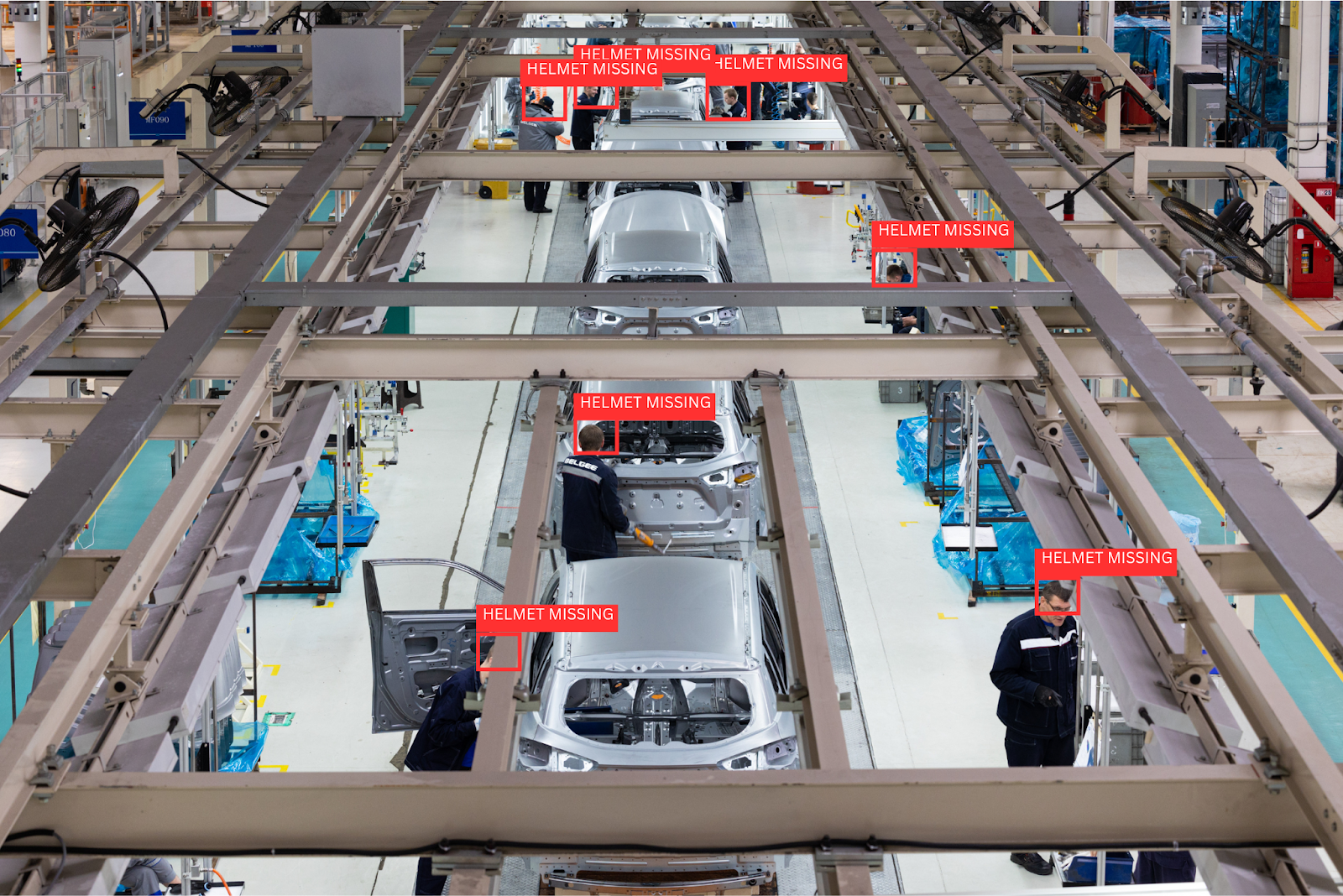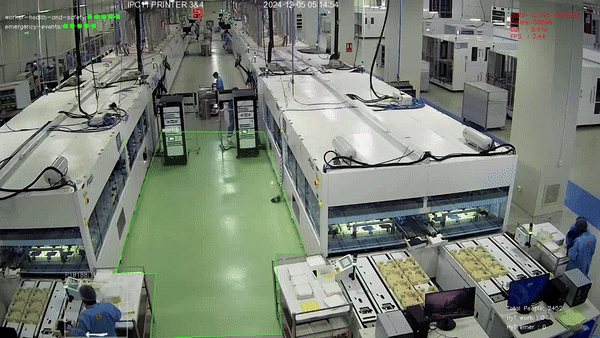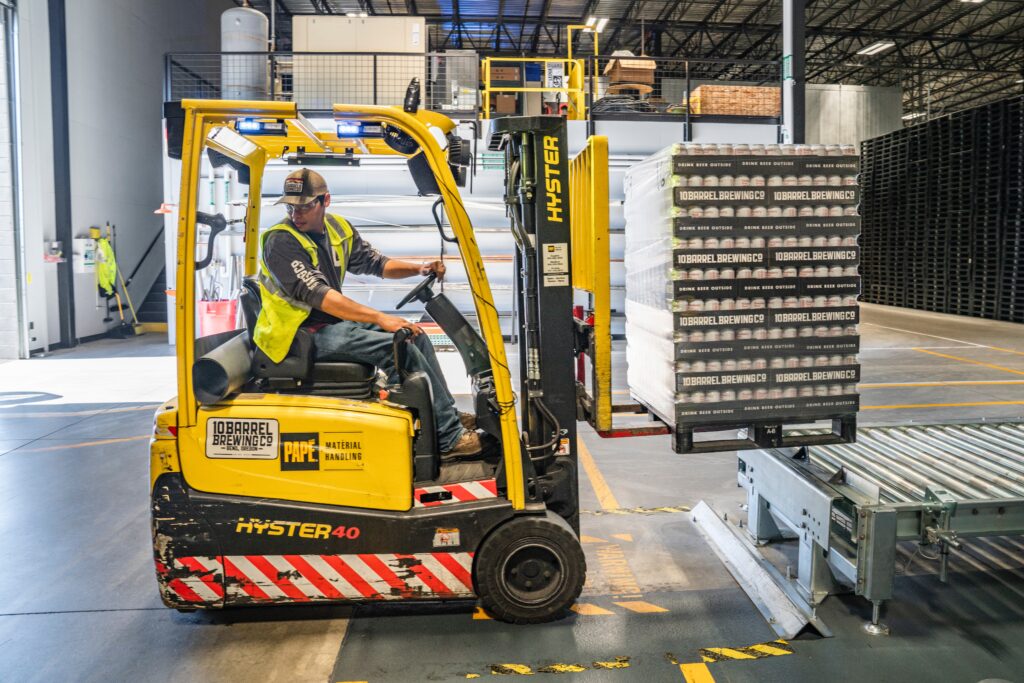Beyond the Human Eye: How Vision AI is Pioneering the Future of Workplace Safety

See It In Action

Safety AI Software in Action
See how Visionify's Safety AI Software monitors workplace safety in real-time
Example Videos
Safety AI Software in Action
See how Visionify's Safety AI Software monitors workplace safety in real-time
Forklift Zone Monitoring with Vision AI
See how Vision AI monitors forklift zones in real-time to prevent accidents
Hard Hat Compliance in Manufacturing
Vision AI PPE Compliance for Manufacturing
Key Takeaways
- Real-time Monitoring: Vision AI provides continuous surveillance without fatigue or distraction
- Proactive Prevention: Detects hazards before they cause accidents, shifting from reactive to preventive safety
- Comprehensive Coverage: Monitors multiple safety aspects simultaneously across entire facilities
- Enhanced Compliance: Ensures adherence to safety protocols and regulations with objective verification
- Augmented Expertise: Complements safety professionals' capabilities rather than replacing human judgment
The Safety Challenge
In today's dynamic workplaces, traditional safety approaches are increasingly insufficient. Manual inspections, while valuable, are limited by human factors like fatigue, oversight, and inconsistency. The statistics tell a sobering story: according to the International Labor Organization, 2.3 million people die annually from work-related accidents and diseases—more than 6,000 deaths every day.
The financial impact is equally staggering. The National Safety Council reports that workplace injuries in the United States alone cost $167 billion in 2021, with 103 million workdays lost. These numbers highlight an urgent need for innovative safety solutions that go beyond conventional methods.
 Vision AI systems can detect safety violations in real-time across multiple areas
Vision AI systems can detect safety violations in real-time across multiple areas
Introducing Vision AI for Workplace Safety
Vision AI represents a revolutionary approach to workplace safety. This specialized form of artificial intelligence analyzes visual data from standard cameras, identifying safety hazards, compliance issues, and potential accidents in real-time.
Unlike human observers who experience fatigue and attention lapses, Vision AI maintains constant vigilance, processing visual information with remarkable speed and precision. The technology doesn't just see—it understands context, recognizes patterns, and makes split-second assessments that can prevent accidents before they occur.
How Vision AI Works
At its core, Vision AI mimics human visual perception but with enhanced capabilities. The system captures video feeds from cameras positioned throughout a facility, then processes this visual data through sophisticated neural networks trained to recognize specific safety concerns.
The technology follows a systematic process:
- Image Acquisition: Cameras capture real-time footage of the workplace
- Pre-processing: Images are enhanced for optimal analysis
- Feature Extraction: The system identifies key visual elements
- Detection & Classification: AI algorithms recognize safety violations or hazards
- Alert Generation: When issues are detected, the system triggers immediate notifications
What makes Vision AI particularly valuable is its ability to learn and improve over time. Through continuous exposure to new data, the system becomes increasingly accurate at identifying safety concerns specific to each workplace environment.
Key Applications in Workplace Safety
1. Hazard Detection and Accident Prevention
Vision AI excels at identifying potential dangers before they cause harm. The system can detect:
- Spills that might cause slips and falls
- Blocked emergency exits
- Unsafe equipment operation
- Fire and smoke in early stages
- Ergonomic issues that could lead to injuries
By spotting these hazards in real-time, Vision AI enables immediate intervention, preventing accidents rather than merely responding to them after they occur.
2. PPE Compliance Monitoring
Personal protective equipment (PPE) is essential for worker safety, but ensuring consistent compliance is challenging. Vision AI provides automated verification that workers are properly equipped with:
- Hard hats in construction zones
- Safety glasses in manufacturing areas
- High-visibility vests near vehicle operations
- Gloves when handling hazardous materials
- Proper respiratory protection in contaminated environments
When violations are detected, the system immediately alerts supervisors, allowing for prompt correction before injuries occur.
 Vision AI automatically verifies proper use of personal protective equipment
Vision AI automatically verifies proper use of personal protective equipment
3. Restricted Area Monitoring
Some workplace zones present heightened dangers requiring special precautions. Vision AI can monitor:
- Access to hazardous chemical storage
- Entry into confined spaces
- Proximity to high-voltage equipment
- Presence in areas with moving machinery
- Unauthorized access to sensitive locations
The system ensures only authorized personnel with proper training and equipment enter these areas, preventing potentially catastrophic incidents.
4. Behavioral Safety Analysis
Beyond physical hazards, Vision AI can identify unsafe behaviors that might lead to accidents:
- Improper lifting techniques
- Dangerous shortcuts in procedures
- Distracted operation of equipment
- Excessive speed in vehicle operation
- Unsafe proximity to machinery
This capability addresses the human factors that contribute to many workplace accidents, promoting safer work practices through timely intervention.
Vision AI in Action: A Real-World Scenario
Imagine a manufacturing facility where workers must wear hard hats, safety glasses, and gloves in designated areas. Traditionally, ensuring compliance requires safety managers to constantly patrol the floor—an impossible task in large operations.
With Vision AI, cameras positioned throughout the facility continuously monitor for PPE compliance. When a worker enters a hazardous area without proper protection, the system immediately:
- Identifies the specific violation (missing hard hat, gloves, etc.)
- Sends an alert to the safety supervisor's mobile device
- Displays the location and nature of the violation
- Records the incident for later analysis and training
This real-time intervention prevents potential injuries while generating valuable data for improving safety programs.
Enhancing Rather Than Replacing Human Expertise
Despite its advanced capabilities, Vision AI is designed to augment rather than replace safety professionals. The technology serves as a force multiplier, handling repetitive monitoring tasks while allowing EHS experts to focus on:
- Analyzing safety trends and patterns
- Developing improved safety protocols
- Implementing targeted training programs
- Addressing complex safety challenges
- Building a stronger safety culture
This partnership between human expertise and AI capabilities creates a more comprehensive safety system than either could achieve alone.
The Future of Workplace Safety
As Vision AI technology continues to evolve, its applications in workplace safety will expand. Future developments include:
- Integration with wearable devices for personalized safety monitoring
- Predictive analytics to forecast potential safety issues before they emerge
- Enhanced environmental monitoring for toxic exposures
- Automated emergency response coordination
- Comprehensive safety performance analytics
These advancements promise to further reduce workplace injuries and fatalities while improving operational efficiency.
 Future of workplace safety with Vision AI
Future of workplace safety with Vision AI
Conclusion
Vision AI represents a paradigm shift in workplace safety—moving from reactive to proactive protection, from periodic inspections to continuous monitoring, and from subjective assessment to data-driven decision-making.
For organizations committed to worker wellbeing, this technology offers an unprecedented opportunity to enhance safety performance while reducing costs associated with workplace accidents. As Vision AI continues to mature, it will become an essential component of comprehensive safety programs across industries.
The future of workplace safety lies not in choosing between human expertise and artificial intelligence, but in harnessing the unique strengths of both to create safer work environments for everyone.
Ready to transform your workplace safety program with Vision AI? Contact Visionify today to learn how our solutions can help protect your workers and enhance your safety performance.
Frequently Asked Questions
Find answers to common questions about this topic
Want to learn more?
Discover how our Vision AI safety solutions can transform your workplace safety.
Schedule a DemoSchedule a Meeting
Book a personalized demo with our product specialists to see how our AI safety solutions can work for your business.
Choose a convenient time
Select from available slots in your timezone
30-minute consultation
Brief but comprehensive overview of our solutions
Meet our product experts
Get answers to your specific questions
Related Articles
Subscribe to our newsletter
Get the latest safety insights and updates delivered to your inbox.


